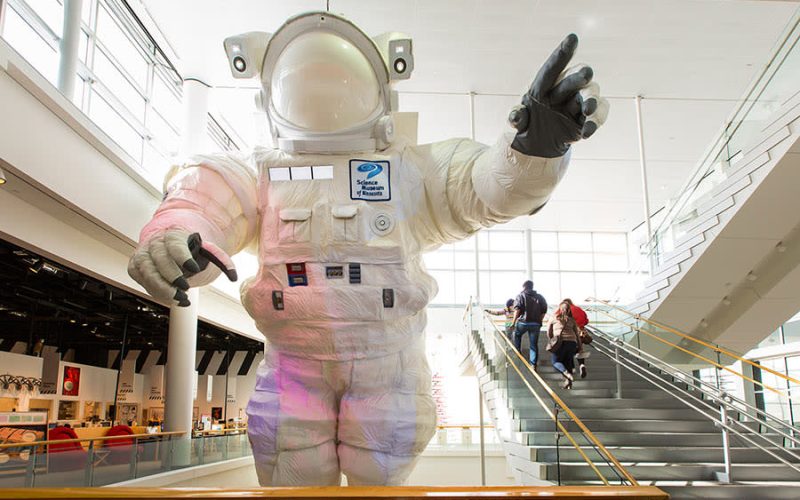
미네소타 과학 박물관
120 W. Kellogg Blvd.
세인트 폴, 미네소타주 55102
미국
초기 설문조사에서 파악하지 못한 기후 변화 문제를 해결하기 위해 어떤 특별한 상황과 이니셔티브를 수행했거나 수행할 계획이 있나요?
미네소타 과학 박물관은 2012년에 최초의 기후 변화 성명서를 채택했으며, 이 성명서는 박물관 웹사이트에 다른 성명서와 함께 게시되어 있고 로비에 전시되어 있습니다. 박물관은 최근 기후 정의의 필요성과 정책 옹호의 중요성을 인정하기 위해 행동의 시급성에 대해 훨씬 더 강력한 표현을 담은 성명서 업데이트를 완료했습니다. 새로운 성명서는 박물관 이사회 집행위원회의 승인을 받았으며 3월 말까지 전체 이사회의 비준을 받을 예정입니다.
미네소타 과학 박물관은 2019년 5월에 탄소 중립을 기관의 목표로 채택했습니다. 2019년 이산화탄소 배출량을 늦어도 2030년까지 50%까지 감축하고 늦어도 2050년까지 탄소 중립을 달성하겠다고 명시적으로 약속했습니다. 과학 박물관은 최근 전기 공급업체인 엑셀 에너지와 계약을 체결하고 이 회사의 윈드소스 프로그램을 통해 100%의 무탄소 전기를 공급받기로 했습니다. 2020년 과학관의 탄소 배출량 중 전기 사용량이 59%를 차지했기 때문에 이번 계약으로 과학관의 탄소 오염을 크게 줄일 수 있을 것으로 기대됩니다. 하지만 박물관의 노력은 여기서 끝나지 않았습니다. 지역 에너지 시스템에서 냉온수 구매는 박물관의 탄소 오염 중 24%를 차지하므로 이제 이러한 배출량을 줄일 수 있는 기회를 모색하는 데 관심을 기울여야 합니다.
기후 변화를 해결하기 위해 활용할 수 있는 커뮤니티의 가장 시급한 문제나 기회는 무엇인가요?
미네소타 과학 박물관 이사회는 2018년 3월에 형평성과 포용성에 관한 성명을 채택했습니다. 이 박물관은 기후 변화가 유색인종, 여성, 원주민 그룹, 부유하지 않은 사람들에게 불균형적으로 영향을 미친다는 사실을 인식하고 새로운 기후 변화 성명서를 통해 형평성과 포용성, 기후 변화에 대한 노력을 서로 활용할 수 있는 기회를 모색할 것입니다. 대부분의 권력은 가장 큰 피해를 입을 가능성이 높은 사람들의 손에 있기 때문에 박물관은 기후 정의를 포용하고 기후 변화의 영향을 가장 많이 받는 사람들의 필요에 초점을 맞추기 위해 최선을 다하고 있습니다.
기후 변화에 대응하기 위해 정원의 어떤 독특한 특징을 활용할 수 있나요?
미네소타 과학 박물관은 1에이커 규모의 공간을 야외 환경 혁신 전시 공간으로 개발하는 중입니다. 이 박물관은 지구를 이용해 건물을 냉난방하는 새로운 방법을 개발한 미네소타에 본사를 둔 회사와 논의 중입니다. 박물관은 일반 관람객, 오피니언 리더, 정책 입안자, 건축 전문가 등 많은 청중에게 첨단 대수층 열전달 기술의 유용성을 보여줄 장소로 미래 과학 공원을 주목하고 있습니다.
기후 변화에 효과적으로 대처하는 데 방해가 되는 기관이나 커뮤니티의 고유한 제약 요인에는 어떤 것이 있나요? 어떻게 하면 이러한 힘의 충돌을 타협에서 벗어나 화해와 화합으로 이끌 수 있을까요?
너무 많은 사람들이 기후변화가 부담스럽다는 이유로 기후변화에 대한 행동에 나서지 않습니다. 미네소타 과학 박물관은 전시, 교육 프로그램, 연구 및 소장품, 리더십, 정책, 실천을 통해 기후 변화에 대한 자원과 기후 행동의 허브가 되기 위해 노력하고 있습니다. 기후 위기의 영향을 완화하고 우리 모두가 더 나은 미래를 상상하고 설계하고 실현할 수 있도록 집단적 해결책을 확대할 것입니다. 우리의 사명을 지침으로 삼아 그렇게 할 것입니다:
다양한 관점, 특히 원주민 문화의 데이터, 증거, 이야기를 공유하여 학습에 영감을 불어넣으세요.
정책 입안자, 기업, 지역사회 리더가 증거에 기반한 결정을 내릴 수 있도록 장려하여 정책에 정보를 제공하세요.
기후 변화의 가장 큰 영향을 받는 사람들의 필요에 초점을 맞추고 기후 정의를 수용하여 삶을 개선하세요. 대부분의 권력은 가장 큰 피해를 입을 가능성이 높은 사람들의 손에 있기 때문입니다.





